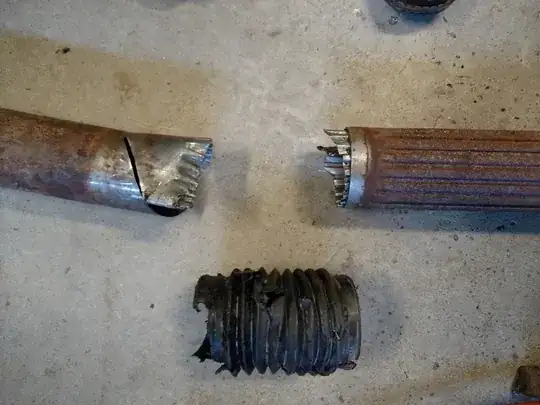I drive a 2007 Ford Explorer XLT 4WD. I stopped at a stop sign and as I was turning right and starting to accelerate(Not very fast). I heard a loud noise and the car stopped moving forward. Turns out that the rear drive shaft has snapped in half. I was able to get the car on a trailer using the front wheels since its 4wd. The broken drive shaft came off fairly easily and it does not look like the U joints or any other visible part is broken. What should I be looking for that could be the cause of a snapped drive shaft. It seems odd that it would just snap on its own accord or because it got worn out. I know I have to replace the drive shaft itself however I do not want to find out that it will just break again because this is the symptom and not the cause.
3 Answers
All we can do it guess. IMO, though not easy to see, it appears the slip joint is corroded.
If the joint is not able to slide in and out as the suspension travels up and down, then it will put undue tensile stress on the joint. Once a crack forms, it is only a matter of time before it twists off.
- 9,015
- 20
- 32
I have only once seen a drive shaft snap. The cause was traced to a faulty batch of steel. The shaft had inclusions within the steel which reduced its strength.
Once found, the company issued a recall on the vehicle model.
This was back in the 1970s so I would hope modern quality control is a little better. But it may be something for you to look for.
- 1,442
- 7
- 24
- 33
Usually drive shaft issues can be attributed to aftermarket engine modifications (more torque) or tires (more traction, and thus a higher peak torque through the shaft). In both those cases slight twisting of the shaft near the failure point will be visible.
It's hard to diagnose from the photo, but I don't think that I see that tell-tale twisting other than the little bit that occurred as the crack propagated. Thus, I would assume this to be an issue with the shaft itself, possibly due to collision damage, and wouldn't hesitate to replace it with a well-inspected junkyard shaft. Save yourself the heavy diagnoses, but keep the old shaft to compare failures if the replacement shaft fails as well.
Additional things that should be inspected when a driveshaft fails include transmission and engine mounts, suspension and swaybar mounts, and of course the undercarriage and anything near the broken shaft (exhaust, fuel lines, brake line including the mechanical parking brake line).
Note that my experience in the matter is mostly with competition vehicles, not 4x4s.
- 1,753
- 2
- 12
- 19
